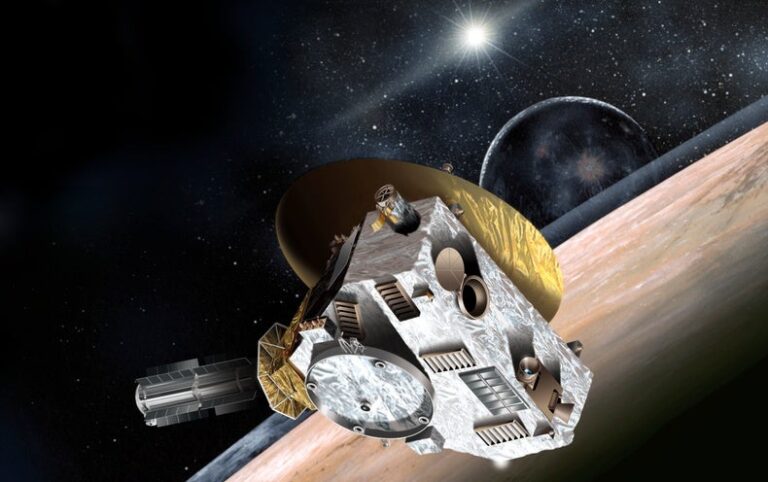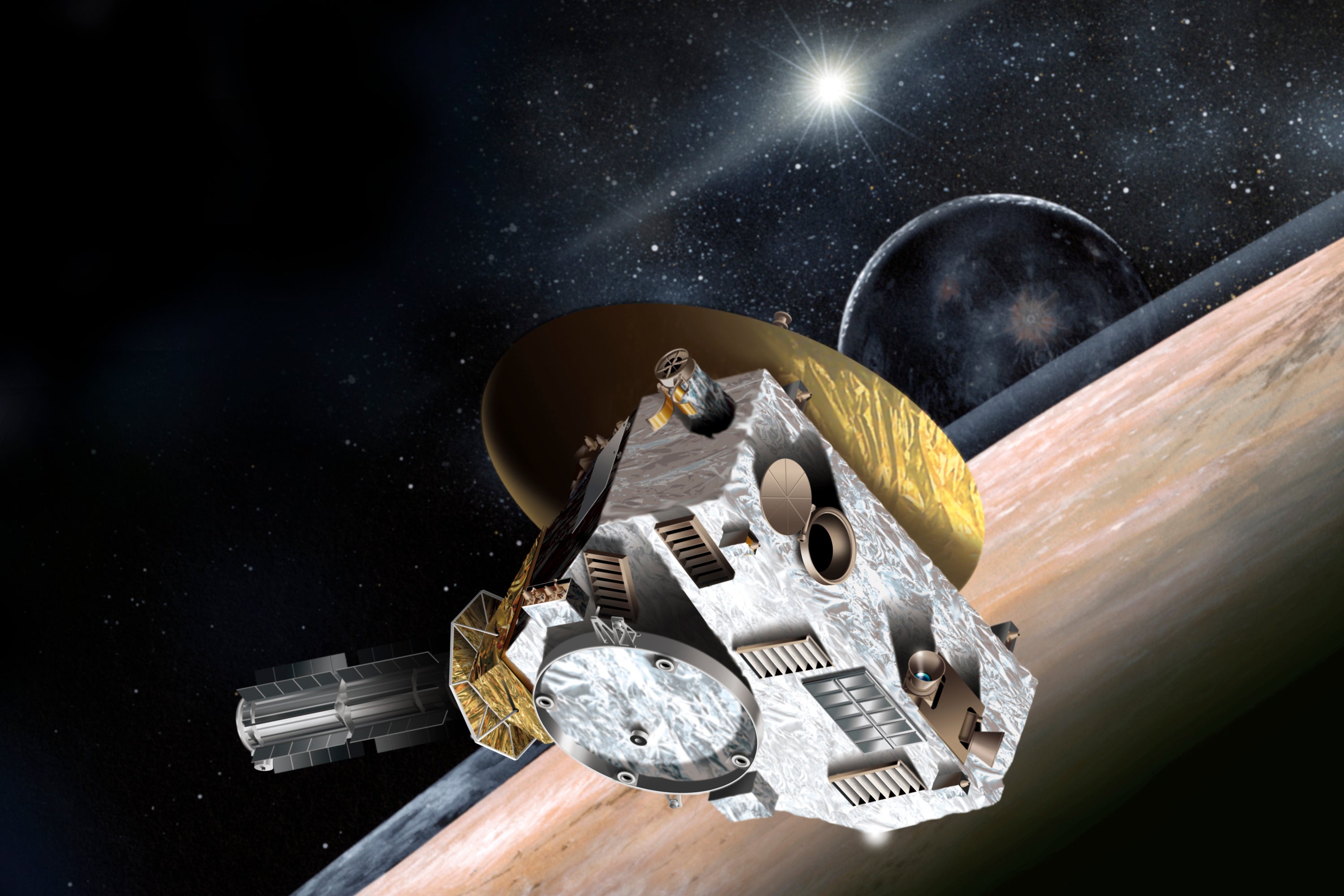
[ad_1]

Only two spacecraft have ever left our solar system and lived to tell the tale. In 2012 and 2019, NASA’s Voyager 1 and 2 spacecraft respectively broke through the heliopause, the boundary at which our sun’s sphere of influence gives way to the interstellar medium. They have sent back remarkable riches from this distant location, humanity’s first foray into the limitless bounds beyond our solar system’s edge. In hot pursuit, however, is a far more advanced vehicle, sporting improved instruments, updated optics, and even a means to sample the interstellar medium itself. New Horizons was launched from Earth in 2006 on a mission to visit Pluto, arriving in 2015 and revealing incredible details during its all-too-brief flyby. The spacecraft has continued its cruise toward interstellar frontiers ever since. It has now begun its second extended mission, and is soon set to wake up from a deep hibernation, opening a wealth of new science opportunities in the outer solar system. “It takes a long time to get to where our spacecraft is,” says Alice Bowman, mission operations manager for New Horizons at the Johns Hopkins University Applied Physics Laboratory (JHUAPL) in Maryland. “When you have a spacecraft that is out in that part of the solar system, it is a huge asset to the scientific community. There are so many unique things that a spacecraft that is out that far can do. We definitely want to take advantage of that.”
For New Horizons, those “unique things” include unprecedented studies of the planets Uranus and Neptune, sampling of the local dust, studies of the background light in the universe, and more. The sum total will be a new phase of the mission that is “really unique and interdisciplinary in nature,” says Alan Stern, the lead on the mission at the Southwest Research Institute (SwRI) in Texas. In October, this two-year second extended mission officially began, but in 2023 it will pick up the pace as the spacecraft exits hibernation and begins its scientific program in earnest. “There were lots of good ideas for how to do things in astrophysics, heliophysics and planetary science,” Stern says. “We took the very best of those.” There is even, also, the tantalizing possibility of visiting another object in the Kuiper Belt, the region of asteroids and icy objects that lurks beyond Neptune, in which New Horizons has already visited one object—Arrokoth in 2019—after its Pluto encounter. Even without such a possibility, there was more than enough reason for NASA to extend the mission. “New Horizons is at a unique location in the solar system with an amazing suite of functioning instruments on-board,” says Becky McCauley Rench, New Horizons program scientist at NASA Headquarters in Washington, D.C. “[It] can provide valuable insights to the heliosphere and the solar wind, astronomical observations of the cosmic background radiation, and valuable data about Uranus and Neptune that can be applied to our knowledge about ice giant planets.”
Since June 1 the spacecraft has been in hibernation, with its major systems switched off to reserve power, while a gentle spin of five revolutions per minute keeps the spacecraft on course without using up its fuel. The spacecraft’s nuclear battery, degraded from its original design spec of 240 watts of power production, now makes about 200 watts, and there are about 11 kilograms of hydrazine fuel left of the 78 kilograms that were aboard when New Horizons launched. “We’re on an eighth of a tank,” Stern says. That makes operations difficult. “It is becoming more challenging,” Bowman says. “We have to be very judicious when we choose activities to do.” That is more than enough power and fuel, however, for the spacecraft’s operations to continue long into the future, perhaps the 2040s or even 2050s, when the spacecraft should have crossed the boundary into interstellar space. New Horizons is currently about 55 astronomical units (AU) from the sun, or 55 times the Earth-sun distance, some 65 AU short of that boundary and traveling outwards at about “three AU per year,” says Stern.
On March 1, the spacecraft will cease to spin and exit its hibernation mode, switching on its systems to truly begin its new extended mission (although some instruments have already been taking data while the rest of the spacecraft has been hibernating). In April, the spacecraft will snap images of the planet Uranus, and later both Uranus and Neptune in the fall of 2023, and Uranus again in spring 2024. This will allow astronomers to track the motion of clouds as the planets rotate to better understand their energy balance as the sun shines upon them particularly when, in the fall of 2023, New Horizons will observe the planets edge-on while Hubble and other ground-based telescopes near-simultaneously observe their nearsides from Earth.
While the planets will only appear as dots of light to New Horizons, the spacecraft should be able to track the change in brightness of the planets that corresponds to observations from Hubble. “It doesn’t have to be exactly simultaneous, but we’re certainly folding in when Hubble can observe to the optimal time for New Horizons to observe,” says Will Grundy at Lowell Observatory in Arizona, a planetary scientist and co-investigator on the mission. Such studies, in turn, could prove useful for investigations of exoplanets in other solar systems. So far, ice giant planets like Uranus and Neptune have been found to be relatively common. By understanding what New Horizons can see in its limited observations of these planets compared to Hubble’s views, astronomers can extrapolate that to understand remote views of similar exoplanets, too. “It’ll get people really sharpening their pencils and figuring out what you can learn from that sort of observation,” Grundy says.
By pointing its cameras outward into deepest space, unhindered by light from the sun, New Horizons has already revealed something surprising about the universe, namely that the background visible light from all the stars and galaxies is about twice as bright as expected. Possible explanations include a smattering of faint galaxies, perhaps invisible to telescopes like Hubble but observable by the James Webb Space Telescope (JWST), or rogue stars drifting through the galaxy. “We’re going to be making even more precise measurements in 16 different directions,” says Stern, compared to just two directions previously. That should explain if the background light is spread evenly across the sky or focused in certain directions. The team will also do the same experiment in ultraviolet, “to rule some ideas ‘in’ or ‘out,’” Stern says.
New Horizons is also able to study its current region of space in more detail than could Voyager 1 and 2. The spacecraft is thought to be in a “desert” between an inner and outer Kuiper Belt region, in which the density of dust and objects is lower than average in the rest of the Kuiper Belt. A dust detector on the spacecraft should pick up a handful of dust impacts every year, and the electromagnetic pulse produced by those impacts should tell scientists how big the dust is and the amount of it, some of which may have resulted from objects colliding in the Kuiper Belt. “It’s a way of tasting the effect of Kuiper Belt collisions,” says Grundy. “Even small objects crash into each other, and we can detect that dust. It’s a way of telling the outermost extent of the Kuiper Belt.” New Horizons will also observe up to 10 or so other Kuiper Belt objects from afar, possibly resolving their shapes and sizes by working in tandem with ground-based telescopes, as well as looking for evidence of small accompanying moons.
As the spacecraft approaches the heliopause, it will also tell us more about how the properties of the sun’s heliosphere, its region of influence, are changing—taking measurements of the local plasma, charged particles and an influx of hydrogen gas from the interstellar medium. “We now have the opportunity of making a global map of the hydrogen distribution,” says Ralph McNutt, chief scientist for space science at JHUAPL and a co-investigator on New Horizons. “It’s part of the clue to how the overall heliosphere interacts with the interstellar medium on a large scale, and what the interstellar medium is doing to our home.” The hope, however, is that the spacecraft will remain operational and funded into the 2040s, when it should have reached the heliopause some 120 AU from Earth. “We think we’ve got enough power on board,” McNutt says.
Yet there is the constant possibility that all of these plans could change in an instant. Using the Subaru Telescope in Hawaii, the team continues to scour the Kuiper Belt for another object to visit, like Arrokoth. If a suitable candidate is found that could be reached by New Horizons, “we would drop the rest of the program to conserve fuel,” says Stern. “We were sent to do the Kuiper Belt.” No such target has yet been found, but the search continues. “If we can get a second Kuiper Belt object, that will trump everything,” says Stern. “If we can find one object that we can reach with the fuel supply, even if it’s four or five years from now, that will be the headliner.” But there is no guarantee of such an outcome. “The odds are not great because we’re through the densest part of the Kuiper Belt,” says Grundy. “It’s a long shot.”
In lieu of such a target being found, the team are also considering another high-profile task as part of its latest extended mission. The spacecraft could be directed to turn around and look back towards Earth, replicating the famous Pale Blue Dot image of our planet taken by Voyager 1 in 1990 from a distance of 40 AU. Stern says the team are currently investigating if this would be feasible. “The problem is we’re much further from the sun than Voyager was,” he says. That could make it too difficult to resolve Earth against the glare of the sun, while the brightness of the sun could potentially damage the spacecraft’s instruments. “We’re not going to burn out the cameras just to do it,” Stern says.
No other spacecraft will traverse this same region of space as New Horizons for decades. In the U.S. an effort led by McNutt called Interstellar Probe is currently being considered as a potential future project, but a decision by the National Academies’ Solar and Space Physics Decadal Survey is not expected until December 2024. While there have been no major updates to the project since the team published its proposal last year, there has been one major development, namely the successful first launch of the Space Launch System (SLS), earmarked as a potential launch vehicle for this ambitious mission. McNutt says his team has also spoken with other companies about possible alternative large rockets that could launch the mission, such as SpaceX’s Starship, which is expected to conduct its first orbital test flight by 2023. “We’re talking to them,” McNutt says. A separate interstellar mission from China, Interstellar Express, also appears to still be on track to launch later this decade.
For now, New Horizons is the only spacecraft barrelling towards the edge of the solar system, and it has two possible futures ahead of it. One is an interdisciplinary study of the outer solar system in a manner that will be unmatched for years to come. “We are going through the outer heliosphere where Voyager went but with vastly better instrumentation,” says Stern. “Our particle instruments are much more sensitive. We have a dust detector. And our ultraviolet spectrometer is being used to study the distribution of neutral hydrogen gas. Voyager just didn’t have the technology to do that.” The other is a diversion towards an as-yet undiscovered asteroid or comet lurking in the outer Kuiper Belt, an alluring but increasingly challenging possibility. “We don’t know how far the Kuiper Belt really extends,” Stern says. “We’re pulling out all the stops. If there’s something out there to get to, we will find it.”
[ad_2]